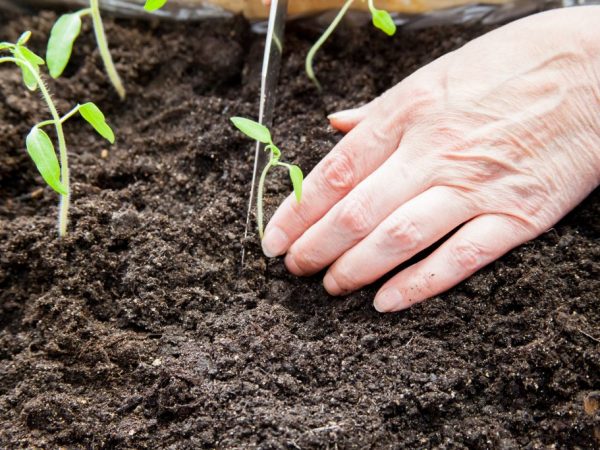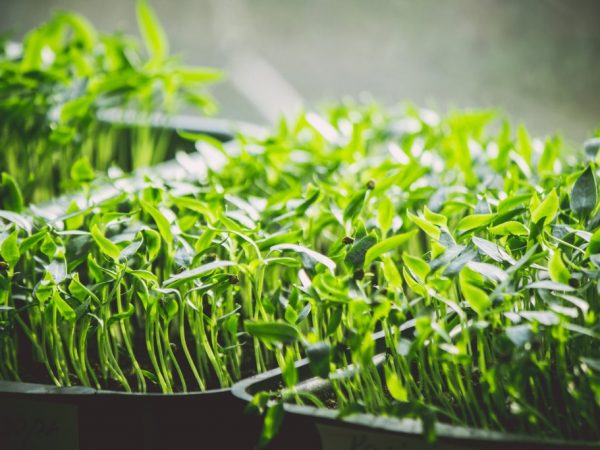Features of picking tomatoes
Tomato picking is the transplanting or transshipment of plant seedlings into a new container. Most farmers consider this procedure to be one of the main conditions for obtaining a good harvest, because after transplanting the root system is strengthened, it is possible to select stronger seedlings if the sowing was too thick. This article discusses how and when to dive tomatoes.

Features of picking a tomato
Why dive tomatoes
Novice farmers ask if tomatoes need a pick at all. The cultivation option with one transplant in greenhouses is possible, but the yield in this case can be low. Without picking, you can grow seeds in separate pots, although in such cases the risk of death of seedlings and diseases increases.
So why transplant tomatoes. The picking of tomato seedlings is carried out for the following purposes:
- Strengthen the root system of the seedlings, allow it to grow in width.
- Plant the seed from one box into separate containers with more nutritious soil.
- Provide more space for seedling growth.
- Select stronger tomatoes for further cultivation.
- Cull diseased plants.
- Slow down the growth of tomatoes if it is too early to plant them in open ground.
- Optimize watering.
The benefits of a dive are great. If you plant seedlings immediately in large containers, the seeds will be poorly ventilated, and the water in a large pot will stagnate. For example, the famous gardener Oktyabrina Ganichkina recommends sowing seeds in small pots with a volume of 100-150 ml, and then diving young tomatoes.
When to dive tomatoes
The benefits of a transplant are undeniable. So when should you dive tomatoes? The date and terms depend on the time when the sowing was carried out. It could be March or early April. Some farmers like to determine auspicious days and numbers according to the lunar calendar. But the most reliable way to determine the moment of transplantation is by the size of the seedlings.
Diving tomatoes should be carried out after the appearance of 2 true leaves. They grow 5 days after the first shoots appear. At this time, the roots of the plants are still very weak - transplanting can damage them. In this regard, the picking of tomato seedlings is recommended to start from the 10th day after the emergence of seedlings. This is the most optimal time. After 15 days, the roots of the overgrown seedlings will intertwine and will be difficult to disconnect without injury.
There is a way to dive tomato seedlings at a later date: a month or one and a half after the seeds germinate. At this time, 4-6 true leaves already appear on the extended branch. In this case, tomatoes should be sown in large containers so that the plants have room for growth and development. It is recommended to take cups with a volume of 0.3-0.5 liters for 7-8 seedlings or large boxes. If the container is too small, the seedlings wither and fall, as they lack moisture and nutrients, therefore it is very important to pick on time.
Preparation of containers and soil
If we talk about how to dive tomatoes correctly, you should start with preparation. If you have everything at hand, the process goes as quickly as possible. So, you need to have:
- Transplant containers (cardboard, plastic, peat cups, plastic bottles). The size of the containers should be about 0.5 L or about 10 cm in diameter.
- Priming. It is best to take equal parts of humus, peat and garden soil. The prepared soil is watered for disinfection with a weak solution of potassium permanganate (0.5 g per 10 l of water). Such processing is mandatory, as it reliably protects tomatoes from diseases.
- A teaspoon or wooden stick for digging up plants.
- Paper or cardboard to cover the windowsill.
There is no consensus on whether to fertilize the soil before diving tomatoes. Some advise you to apply top dressing right away, others recommend waiting 6-8 days for the plants to get used to it. We will consider the second option at the end of the article, since most believe that tomatoes should be dived into unfertilized soil.
Tomato transplant process

The pick takes place in several stages.
Before you start diving tomatoes, stop watering for 1-2 days. Too moist soil holds the roots tightly, therefore plants need to be transplanted from slightly dried loose soil. The landing pattern consists of several stages:
- The seedling is carefully dug out with a spoon or stick, holding the cotyledonous leaves so as not to break the stem.
- Take the small tomato out of the container where it is growing.
- The rhizome can be cut into 2/3 parts with nail scissors. If it is small, the plant is planted. In a small pot, the roots begin to grow independently to the sides, since there is no place for them below.
- A small indentation is made in the transplant pot.
- The seedling is transferred by lowering it into the ground to the level of the cotyledonous leaves.
- Sprinkle with earth and tamp a little.
- On the day of transplanting, they are watered with water at room temperature, then the seedlings are left without water for a while.
After you finish diving the tomatoes, they must be placed in a shaded place for 2-3 days so that the roots are well fixed. Then the plants are transferred to light, hardened in the open air. The optimum temperature in the room where young seedlings grow is 15-18 ° C. In the first days after a dive during the day, it can be maintained at a level of 18-20 ° C. It is not recommended to water the tomato 5-6 days after transplanting, so that the roots are well strengthened and fungi or bacteria do not grow in the ground, from which the seedling dies.
Top dressing of seedlings
After the picking of tomato seedlings is finished, you need to wait 8-10 days. This time is needed to adapt to new growth conditions. Then fertilizers are applied to the soil. It is best to use ready-made universal mixes Agricola, Vegeta and others. How much they need to be brought into the ground is written on the package. The second feeding is carried out 2 weeks after the dive of the tomatoes.
If desired, you can prepare the fertilizer yourself, before diving the tomatoes or a little later. For the first feeding, you can use nitrogen fertilizers, such as urea. 1 tbsp. l. the substances are dissolved in 10 liters of water and watered with this plant. For the second feeding, take nitrophoska or superphosphate, dilute in the same way as urea: 1 tbsp. l. 10 liters of water. Such care will ensure good health of the seedlings and an excellent harvest in the future.
If it becomes necessary to accelerate the growth of seedlings, it can be sprayed with stimulants (Epin, Bud, etc.) It is important to monitor whether pests have appeared on the leaves. For prevention, sprinkle the ground around the seedlings with black pepper, spray the plants with infusion of garlic (30 g per 1 liter of water). Before diving varietal tomato seedlings, they are treated with phytosporin. So that vegetables do not die from fungi and bacteria, you should carefully monitor the humidity of the air and soil. The room should be dry, watering is provided moderately so that the water does not stagnate.
Second pick and landing in the greenhouse
After 4-5 weeks after the first transplant, they can be transferred to the greenhouse. Experienced gardeners recommend that the time between picking tomatoes and planting them in the ground should be at least 30-45 days. The planting rules in the greenhouse are as follows:
- The width of the bed is 1-1.2 m.
- It is best to plant in a checkerboard pattern.
- The distance between plants is 50 cm.
- Planting depth - 10 cm.
It is advisable to take the seedlings out of the pots and plant them together with an earthen clod. It is placed in the hole at an angle or to one side. Previously, on the same day, a handful of humus should be poured into the depression. The seedling is first sprinkled in half, then watered so that the earth settles, and loose soil is poured.
If the seedlings have already grown, but it is too early to plant them in the ground, it is allowed to re-dive tomato seedlings. To do this, take containers 1.5-2 times larger than the previous ones. The second unmarking looks the same as the first. If you pinch the roots, the growth process can slow down significantly, and the transplant calendar will shift. It is worth carrying out this manipulation only if you expect that the tomatoes will grow indoors for several more weeks.
Strong seedlings have excellent resistance, they are rarely affected by diseases. Correct planting of seedlings and sowing seeds will allow you to grow a good harvest of tomatoes. In the spring you need to put in a little effort, but in the summer you can enjoy delicious fresh vegetables.


